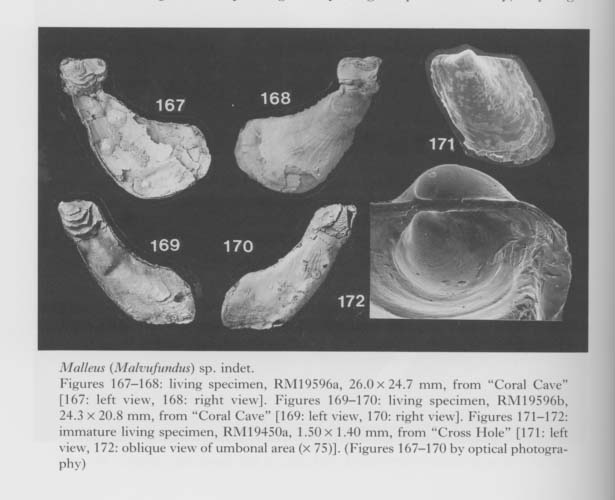Order Pterioida Newell, 1965
Superfamily Pterioidea Gray, 1847
Family Malleidae Lamarck, 1819
Genus Malleus Lamarck, 1799
Subgenus Malvufundus de Gregorio, 1885
Malleus (Malvufundus) sp. indet.
Figures 167-172

The present species is represented by several living specimens collected from the following caves: "Witch's House" (RM19594), "Toriike" (RM19595) and "Coral Hole" (RM19596) of Shimoji Islet, and "Cross Hole" (RM19450) of Irabu Islet, Miyako Islands. According to divers, a number of individuals forming colonies attach themselves by the byssus to some narrow cavities on the cave walls. The byssus is so strong that one can hardly remove the individual without breaking the shell.
The shell is irregular in shape but generally elongated posteroventrally, very fragile but commonly reinforced with an axial internal ridge, less than 45 mm in length, translucent, commonly yellowish in color but sometimes with brownish streaks, RV is moderately convex, while LV is nearly flat or a little concave. Weak irregular radial (or slightly divergent) costellae are often distributed on the surface.The simple prismatic outer layer is well developed, and each calcite prism both on the internal and external surface is about 30-50 µm in diameter. The nacreous inner layer is very thin and restricted to the early dissoconch.
The early dissoconch, commonly 4-7 mm in length and height, is always darkly colored and rather clearly delimited. Unlike the irregularly elongated later dissoconch, it is pteriform and subtrapezoidal with irregularly imbricated commarginal lamellae, anteriorly auriculated, inflated more strongly in LV. The primary ligament is alivincular with a subvertical triangular pit just below the umbo. A weak posterior tooth extends along the posterior part of the dorsal margin. Pd I is small and about 70 µm in diameter; veliconch (Pd I + Pd II) is about 380 µm in diameter and clearly marked. After the pteriform stage, the later dissoconch grows only posteroventrally to form an elongated valve.
The present specimens are probably related to Malleus (Malvufundus) regiila (Forskål, 1775) and Malleus (Malvufundus) irregularis Jousseaume, 1894, from various shallow seas of the Indo-West Pacific. It shares many characters with the two species: especially the distribution of the nacreous inner layer and strong commarginal lamellae which are restricted to the pteriform early dissoconch. A similar axial internal ridge also occurs in M. (M.) irregularis. The shell is, however, much smaller and narrower, and the hinge line is shorter. The pteriform part of the early dissoconch commonly grows 10-20 mm in ordinary individuals of M. (M.) regula and M. (M.) irregularis, but rarely exceeds 6 mm in the present specimens.
It is still indeterminable whether these cave specimens represent a distinct species or only ecophenotypically stunted populations of M. (M.) irregularis. Similar shells occur in the bottom sediments of "Balicasag Cave" of Bohol Island, the Philippines.
Order Ostreoida Férussac, 1822
Suborder Pectinina Waller, 1978
Superfamily Pectinoidea Rafinesque, 1815
Family Propeamussiidae Abbott, 1954
Although some confusion arose as to the systematics of deep-sea translucent scallops, the contents and limits of the Propeamussiidae have become much clearer in recent years based on the characteristic shell microstructure (especially the simple prismatic outer layer of the disk of RV) and absence of tentacles and true ctenolium (Waller, 1972, 1984; Hayami, 1988a; Schein, 1989; Carter, 1990; etc.). The prismatic microstructure of RV dampens the development of surface sculpture except for dense commarginal lamellae and forms a flexible marginal apron in the Propeamussiidae. The shell of this family is therefore highly inequivalve.
All five unfamiliar minute scallops from the submarine caves of the Ryukyu Islands belong to the Propeamussiidae instead of the Pectinidae. Abraded valves of pectinids are occasionally found in association, but they are believed to have been accidentally transported from exposed environments. Four propeamussiids from these caves are assigned to cavernicolous species because they are commonly found alive in some caves. One species belongs to Parvamussium, one to Cyclopecten, and the remaining two to Chlamydella. All of these cave scallops are characterized by large Pd I and absence of Pd II, indicating non-planktotrophic development. Many dead specimens from a few caves of Shimoji Islet are attributable to another species of Parvamussium, which also inhabits the lower sublittoral hard bottom outside the caves.
Genus Parvamussium Sacco, 1897
Many Japanese malacologists and paleontologists (e.g. Habe, 1977a; Hayami, 1988a, b) have traditionally applied the generic name Polynemamussium Habe, 1951, [type species: Pecten intuscostatus Yokoyama, 1920] to byssate and internally ribbed propeamussiids from the northern Pacific, while such species are generally included in Parvamussium by European and American authors. Dautzenberg and Bavay (1912) described several species of byssate propeamussiids from the western tropical Pacific encountered by the Siboga Expedition, some of which closely resemble Pecten intuscostatus. The diagnostic characters of many minute propeamussiids in the Indonesian seas, including the Siboga species, became clear through Dijkstra's (1991) 'comprehensive study and accompanying SEM photomicrographs. The type-species of Polynemamussium may also be very close in every essential character to Parvamussium holmesii (Dall, 1886) from the lower sublittoral to bathyal waters of the West Indies. In view of these studies, we here regard Polynemamussium as a junior synonym of Parvamussium, as it was treated by Rombouts (1991). However, some supraspecific distinction may be needed for a few large-sized northern Pacific species such as Parvamussium alaskensis Dall, 1872, which have also been included in Polynemamussium by Japanese authors.
So far as we are aware, Parvamussium, except for the group of P. alaskense in boreal seas, had been known only from lower sublittoral and deeper substrata, and the following cryptic species may represent the first record of this genus from the upper sublittoral zone.